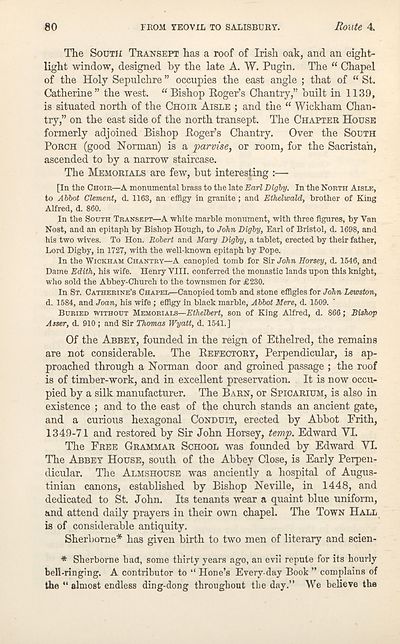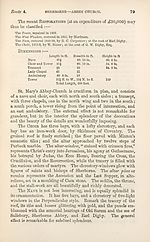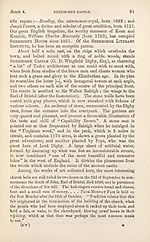Download files
Complete book:
Individual page:
Thumbnail gallery: Grid view | List view

80
FROM YEOVIL TO SALISBURY.
Route 4.
The South Transept has a roof of Irish oak, and an eight-
light window, designed by the late A. W. Pugin. The “ Chapel
of the Holy Sepulchre ” occupies the east angle ; that of “ St.
Catherine” the west. “Bishop Roger’s Chantry,” built in 1139,
is situated north of the Choir Aisle ; and the “ Wickham Chan¬
try,” on the east side of the north transept. The Chapter House
formerly adjoined Bishop Roger’s Chantry. Over the South
Porch (good Norman) is a parvise, or room, for the Sacristan,
ascended to by a narrow staircase.
The Memorials are few, but interesting :—
[In the Choir—A monumental brass to the late Earl Digby. In the North Aisle,
to Abbot Clement, d. 1163, an effigy in granite; and Ethelwald, brother of King
Alfred, d. 860.
In the South Transept—A white marble monument, with three figures, by Van
Nost, and an epitaph by Bishop Hough, to John Digby, Earl of Bristol, d. 1698, and
his two wives. To Hon. Robert and Mary Digby, a tablet, erected by their father,
Lord Digby, in 1727, with the well-known epitaph by Pope.
In the Wickham Chantry—A canopied tomb for Sir John Horsey, d. 1546, and
Dame Edith, his wife. Henry VIII. conferred the monastic lands upon this knight,
who sold the Abbey-Church to the townsmen for £230.
In St. Catherine’s Chapel—Canopied tomb and stone effigies for John Lewston,
d. 1584, and Joan, his wife ; effigy in black marble, Abbot Mere, d. 1509.
Buried without Memorials—Ethelbert, son of King Alfred, d. 866; Bishop
Asser, d. 910 ; and Sir Thomas Wyatt, d. 1541.]
Of the Abbey, founded in the reign of Ethelred, the remains
are not considerable. The Refectory, Perpendicular, is ap¬
proached through a Norman door and groined passage ; the roof
is of timber-work, and in excellent preservation. It is now occu¬
pied by a silk manufacturer. The Barn, or Spicarium, is also in
existence ; and to the east of the church stands an ancient gate,
and a curious hexagonal Conduit, erected by Abbot Frith,
1349-71 and restored by Sir John Horsey, temp. Edward VI.
The Free Grammar School was founded by Edward VI.
The Abbey House, south of the Abbey Close, is Early Perpen¬
dicular. The Almshouse was anciently a hospital of Augus-
tinian canons, established by Bishop Neville, in 1448, and
dedicated to St. John. Its tenants wear a quaint blue uniform,
and attend daily prayers in their own chapel. The Town Hall
is of considerable antiquity.
Sherborne* has given birth to two men of literary and scien-
* Sherborne had, some thirty years ago, an evil repute for its hourly
bell-ringing. A contributor to “ Hone’s Every-day Book ” complains of
the “ almost endless ding-dong throughout the day.” We believe the
FROM YEOVIL TO SALISBURY.
Route 4.
The South Transept has a roof of Irish oak, and an eight-
light window, designed by the late A. W. Pugin. The “ Chapel
of the Holy Sepulchre ” occupies the east angle ; that of “ St.
Catherine” the west. “Bishop Roger’s Chantry,” built in 1139,
is situated north of the Choir Aisle ; and the “ Wickham Chan¬
try,” on the east side of the north transept. The Chapter House
formerly adjoined Bishop Roger’s Chantry. Over the South
Porch (good Norman) is a parvise, or room, for the Sacristan,
ascended to by a narrow staircase.
The Memorials are few, but interesting :—
[In the Choir—A monumental brass to the late Earl Digby. In the North Aisle,
to Abbot Clement, d. 1163, an effigy in granite; and Ethelwald, brother of King
Alfred, d. 860.
In the South Transept—A white marble monument, with three figures, by Van
Nost, and an epitaph by Bishop Hough, to John Digby, Earl of Bristol, d. 1698, and
his two wives. To Hon. Robert and Mary Digby, a tablet, erected by their father,
Lord Digby, in 1727, with the well-known epitaph by Pope.
In the Wickham Chantry—A canopied tomb for Sir John Horsey, d. 1546, and
Dame Edith, his wife. Henry VIII. conferred the monastic lands upon this knight,
who sold the Abbey-Church to the townsmen for £230.
In St. Catherine’s Chapel—Canopied tomb and stone effigies for John Lewston,
d. 1584, and Joan, his wife ; effigy in black marble, Abbot Mere, d. 1509.
Buried without Memorials—Ethelbert, son of King Alfred, d. 866; Bishop
Asser, d. 910 ; and Sir Thomas Wyatt, d. 1541.]
Of the Abbey, founded in the reign of Ethelred, the remains
are not considerable. The Refectory, Perpendicular, is ap¬
proached through a Norman door and groined passage ; the roof
is of timber-work, and in excellent preservation. It is now occu¬
pied by a silk manufacturer. The Barn, or Spicarium, is also in
existence ; and to the east of the church stands an ancient gate,
and a curious hexagonal Conduit, erected by Abbot Frith,
1349-71 and restored by Sir John Horsey, temp. Edward VI.
The Free Grammar School was founded by Edward VI.
The Abbey House, south of the Abbey Close, is Early Perpen¬
dicular. The Almshouse was anciently a hospital of Augus-
tinian canons, established by Bishop Neville, in 1448, and
dedicated to St. John. Its tenants wear a quaint blue uniform,
and attend daily prayers in their own chapel. The Town Hall
is of considerable antiquity.
Sherborne* has given birth to two men of literary and scien-
* Sherborne had, some thirty years ago, an evil repute for its hourly
bell-ringing. A contributor to “ Hone’s Every-day Book ” complains of
the “ almost endless ding-dong throughout the day.” We believe the
Set display mode to:
![]() Universal Viewer |
Universal Viewer | ![]() Mirador |
Large image | Transcription
Mirador |
Large image | Transcription
| Antiquarian books of Scotland > Adventure and adventurers > Black's guide to the counties of Dorset, Devon, & Cornwall > (102) |
|---|
| Permanent URL | https://digital.nls.uk/142587602 |
|---|
| Description | Thousands of printed books from the Antiquarian Books of Scotland collection which dates from 1641 to the 1980s. The collection consists of 14,800 books which were published in Scotland or have a Scottish connection, e.g. through the author, printer or owner. Subjects covered include sport, education, diseases, adventure, occupations, Jacobites, politics and religion. Among the 29 languages represented are English, Gaelic, Italian, French, Russian and Swedish. |
|---|

